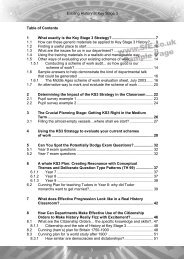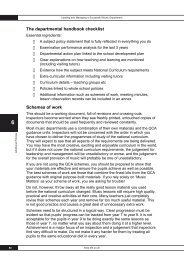How to Write an Effective SEF - SfE
How to Write an Effective SEF - SfE
How to Write an Effective SEF - SfE
You also want an ePaper? Increase the reach of your titles
YUMPU automatically turns print PDFs into web optimized ePapers that Google loves.
<strong>How</strong> <strong>to</strong> <strong>Write</strong> <strong>an</strong> <strong>Effective</strong> <strong>SEF</strong><br />
What <strong>to</strong> <strong>Write</strong> – Ofsted Guid<strong>an</strong>ce<br />
The <strong>SEF</strong> includes some introduc<strong>to</strong>ry guid<strong>an</strong>ce by Ofsted. Ensure you read this first<br />
<strong>an</strong>d the accomp<strong>an</strong>ying section guid<strong>an</strong>ce given before writing. It lists the three<br />
sections you need <strong>to</strong> complete, when <strong>to</strong> do so, who it is for <strong>an</strong>d provides a brief<br />
account of how <strong>to</strong> fill in the form.<br />
Other General Points <strong>to</strong> Note<br />
• Acronyms should only be used once they have been explained, as they may<br />
not be readily unders<strong>to</strong>od by others.<br />
• Referencing <strong>to</strong> pertinent evidence sources/documents is always difficult <strong>to</strong><br />
achieve when trying <strong>to</strong> produce a concise evaluation. One way which c<strong>an</strong><br />
work well is <strong>to</strong> list at the beginning or end of each section (or indeed at the<br />
beginning of the <strong>SEF</strong>), the evidence sources, code them <strong>an</strong>d apply the code at<br />
the relev<strong>an</strong>t positions throughout the sections.<br />
Eg Attainment on entry <strong>an</strong>alysis document (AOEA)<br />
• Whilst it is helpful <strong>to</strong> use the <strong>SEF</strong> as a notebook, ie putting bullet pointed two<br />
<strong>an</strong>d three word phrases in each section as a starting point, be sure that it does<br />
not s<strong>to</strong>p here.<br />
• Beware of raising new points in a long section, if they would more naturally fit<br />
in other sections. Cross referencing is the <strong>an</strong>swer.<br />
• Ensure that comments made are evaluative.<br />
• Where good <strong>an</strong>d outst<strong>an</strong>ding judgements are made, ensure they are backed<br />
up with clear evidence that such a provision impacts in a good or outst<strong>an</strong>ding<br />
way on the students’ achievement.<br />
• Tell the truth, don’t try <strong>an</strong>d cover up, within reason. It soon becomes apparent<br />
when comparing the P<strong>an</strong>dA <strong>an</strong>d the <strong>SEF</strong> where the problems are likely <strong>to</strong> be.<br />
• Check contents against headings, <strong>to</strong> ensure comments are in the correct<br />
section.<br />
• Avoid implying or ‘crystal ball gazing’. Give only subst<strong>an</strong>tiated facts rather th<strong>an</strong><br />
what might happen.<br />
• Where possible, when using the term ‘outst<strong>an</strong>ding’, try <strong>an</strong>d give impartial<br />
evidence sources which have evaluated the provision as such. An outst<strong>an</strong>ding<br />
claim will usually ensure closer scrutiny of this feature by Ofsted.<br />
• Try not <strong>to</strong> run out of steam by section 5, as sections 5 <strong>to</strong> 7 are very import<strong>an</strong>t<br />
yet are often the least well covered. Sections 1 <strong>an</strong>d 2 are often <strong>to</strong>o elaborate<br />
at the expense of the latter ones.<br />
6








